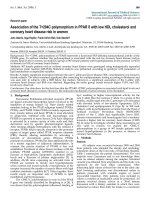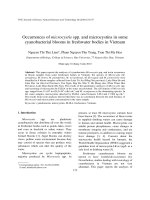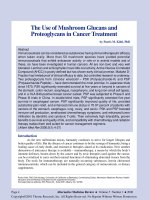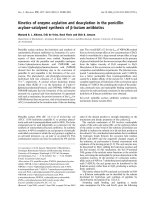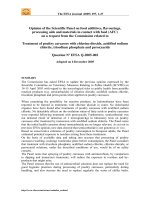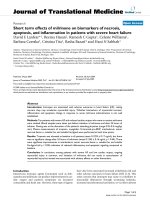Identification of Staphylococcus pseudintermedius and MRSP in dogs with pyoderma by PCR
Bạn đang xem bản rút gọn của tài liệu. Xem và tải ngay bản đầy đủ của tài liệu tại đây (404.61 KB, 8 trang )
Int.J.Curr.Microbiol.App.Sci (2020) 9(8): 775-782
International Journal of Current Microbiology and Applied Sciences
ISSN: 2319-7706 Volume 9 Number 8 (2020)
Journal homepage:
Original Research Article
/>
Identification of Staphylococcus pseudintermedius and MRSP
in Dogs with Pyoderma by PCR
B. Soumya¹, M. A. Kshama²*, Srikrishna Isloor³ and Veeresh B. Hanchinal3
1
Veterinary Officer, Shimoga, Karnataka, India
Department of Veterinary VCC, Veterinary College, Bangalore, India
3
Department of Veterinary Microbiology, Veterinary College, Bangalore, India
2
*Corresponding author
ABSTRACT
Keywords
Pyoderma,
Staphylococci,
S. pseudintermedius,
Methicillin Resistant
S pseudintermedius
(MRSP),
mecA gene
Article Info
Accepted:
10 July 2020
Available Online:
10 August 2020
Pyoderma is one of the most common dermatological disorders encountered in small
animal practice. Almost ninety per cent of the cases of pyoderma in dogs is caused by
bacteria belonging to the genus Staphylococcus and now Staphylococcus pseudintermedius
is recognized as the main etiological agent responsible for pyoderma Further, Methicillin
Resistant S pseudintermedius is being reported worldwide and represents a serious threat
to the health of dogs. However not much work on S pseudintermedius has been done in
India. Hence the study, with the primary objective being isolation, identification and
genotypic characterization of staphylococcal organisms responsible for pyoderma in dogs
along with detection of genotypic resistance to methicillin in these organisms. Dogs
presented to the Veterinary College Hospital, Bangalore with clinical signs suggestive of
pyoderma were chosen as subjects for the study. Materials from lesions from these dogs
were collected, processed and cultured in Mannitol Salt Agar. DNA extracted from these
isolates were subjected to multiplex PCR using species specific primers and were also
tested for methicillin resistance genotypically by PCR targeting the mecA gene. All the
twenty isolates were staphylococci and eleven of the isolates were found to be S
pseudintermedius and nine were S aureus. Sixteen of the twenty isolates were resistant to
methicillin genotypically on PCR. The study conclusively proved the occurrence of S
pseudintermedius in dogs with pyoderma which probably has not been reported from
India. Further, it also proved the occurrence of methicillin resistant S pseudintermedius
and S aureus in dogs with pyoderma which could be important from the perspective of
therapeutic management of pyoderma
identification of exact etiology is the key for
successful therapeutic management (Scott and
Paradis, 1990). Pyoderma is one of the most
common
dermatological
disorders
encountered in small animal practice. Almost
ninety per cent of the cases of pyoderma in
dogs are caused by coagulase positive
Introduction
Dermatological disorders in dogs are of major
concern due to its multiple etiological factors,
higher cost of treatment and the long duration
of therapy and management required.
Therefore
appropriate
diagnosis
and
775
Int.J.Curr.Microbiol.App.Sci (2020) 9(8): 775-782
Staphylococci. In the the early 70s and 80s,
Staphylococcus aureus was believed to be the
main organism responsible for pyoderma.
More recently, biotyping methodology for
coagulase positive staphylococcal species
indicated that the pathogenic coagulase
positive staphylococcus in the dog was
Staphylococcus intermedius (Berg et al.,
1984). Of the staphylococcal species,
Staphylococcus intermedius has been
implicated in approximately 90% of cases of
pyoderma in dogs. However, in actuality,
isolates based on phenotypical characteristics
originally identified as S. intermedius have
been found to be from three different species,
Staphylococcus intermedius, Staphylococcus
pseudintermedius
and
Staphylococcus
delphini. For definitive identification of these
species, molecular diagnostic methods, such
as polymerase chain reaction (PCR)
techniques are required (Bannoehr et al.,
2009) and the term Staphylococcus
intermedius Group (SIG) is now used to refer
to the three previously mentioned isolates (S.
intermedius, S. pseudintermedius and S.
delphini) as a group (Bannoehr et al., 2007
and Sasaki et al., 2007).
Methicillin resistance in S pseudintermedius
similar to S aureus is mediated by the mecA
gene which encodes the penicillin binding
protein 2a (PBP 2a) which has low affinity for
beta lactam antimicrobials and therefore
confers resistance to staphylococcus (Moon,
2012). In 2013, Videla stated that methicillin
resistance
and
resistance
to
other
antimicrobials regularly used by veterinarians
is common among S. intermedius which can
complicate treatment. The first report of mecA
gene responsible for methicillin resistance in
S. intermedius was in 1999 and MRSP was
first reported in 2005. Since then, resistance
to methicillin and to other antimicrobials has
become increasingly common, making this
bacterium
a
possible
reservoir
for
antimicrobial resistance genes.
Thus, taking into consideration the fact that
Staphylococcus
pseudintermedius
is
recognized as the main etiological agent
responsible for pyoderma and that not much
work has been done in India to detect the
presence of this bacteria, this study was taken
up. Further, Methicillin Resistant S
pseudintermedius (MRSP) is being reported
worldwide and represents a serious threat to
the health of dogs and yet not much work on
MRSP has been done in India.
Consequently, since the reclassification of the
species, it has been proposed that all canine
isolates belonging to the SIG should be
considered as S. pseudintermedius unless
proven otherwise by genetic typing methods
(Devriese et al., 2008). Staphylococcus
pseudintermedius is a canine commensal and
opportunistic pathogen, which is analogous to
S. aureus in human beings. Antibiotic
resistance in staphylococci is of great concern
due to increasing incidence of methicillin
resistance among staphylococci. Of late,
several reports are emerging of methicillin
resistance in SIG. Also, a high rate of
multidrug resistance is being reported among
Methicillin Resistant S. pseudintermedius
(MRSP) strains in dogs (Schwarz et al.,
2008).
The primary objectives of the study were to
detect the occurrence of different species of
staphylococci
with
emphasis
on
S
pseudintermedius and to detect methicillin
resistance
in
different
species
of
staphylococci causing pyoderma in dogs.
Materials and Methods
Culture, Coagulase, Catalase testing and
Gram’s staining
Twenty animals presented to Veterinary
College, Bangalore with clinical signs
suggestive of pyoderma such as papules,
776
Int.J.Curr.Microbiol.App.Sci (2020) 9(8): 775-782
pustules, erythema, alopecia, pruritus and
epidermal collarettes were selected as subjects
for bacterial culture, coagulase and catalase
testing, Grams staining and molecular studies.
Samples were collected from the lesions using
sterile cotton swabs and subjected to bacterial
culture, primarily using nutrient broth or brain
heart infusion broth and subcultured using
Mannitol Salt Agar. All plates were incubated
aerobically at 37˚C for 18-24 hrs for
observation of characteristic growth and
tentative identification was done based on the
morphology of colonies. Individual colonies
were selected and catalase and coagulase
testing (tube coagulase) was done as per
standard procedure (Elmer et al, 1988) and
Gram’s staining was done and biochemical
characterization
was
done
using
a
commercially available kit (HiStaph kit,
Himedia, Mumbai, India)
5. Final extension at 72°C for 10 min
6. Hold at 4° C
After completion of PCR, 3 ul of the
amplified products along with 100 bp DNA
ladders mixed with 6X gel loading dye were
subjected to electrophoresis on 2 % agarose
gel (prepared using TAE buffer, agarose and
Ethydium Bromide). One positive control and
one negative control were used with the test
samples. The PCR product size was
determined by comparing with a standard
molecular marker (DNA ladder) and the
images
were
captured
using
Gel
Documentation system.
Detection of methicillin resistance by PCR
The extracted DNA from all the twenty
isolates were utilized for molecular studies on
methicillin resistance targeting the mecA
gene. PCR was carried out using a
programmable master cycler (Eppendorf,
Hamburg, Germany).The reaction mixture
volume was 25 ul. (using 10X Taq buffer,
Taq polymerase, dNTPs, Primers, Template
and Nuclease Free Water) PCR was carried
out with the following thermal cycler
conditions
DNA extraction and PCR
The isolates from culture were subjected to
DNA extraction as per the standard protocol
prescribed by the manufacturer using a kit
procured commercially (AMpurE Bacterial
gDNA Mini Spin, Amnion Biosciences Pvt
Ltd, Bangalore, India) and Multiplex PCR
(m-PCR) was carried out for identification of
staphylococcus to the species level targeting
the nuc gene loci for differentiation of species
using the primer sequences given in Table 1
(Sasaki et al, 2010).
1. Initial denaturation at 94° C for 1 min
followed by
2. Denaturation at 94° C for 30 sec
3. Annealing at 50° C for 1 min
4. Extension at 72° C for 2 min
5. Final extension at 72°C for 10 min
6. Hold at 4° C
Multiplex PCR was carried out using a
programmable master cycler with a reaction
mixture volume of 25 ul. The DNA samples
were subjected to thermal cycling conditions
as given below
The steps 2, 3, 4 were repeated (programmed)
for 30 cycles. After completion of PCR, 3 ul
of the amplified products along with 100 bp
DNA ladders mixed with 6X gel loading dye
were subjected to electrophoresis on 2 %
agarose gel (prepared using TAE buffer,
agarose and Ethydium Bromide).One positive
control and one negative control were used
1. Initial denaturation at 95° C for 10 min
followed by
2. Denaturation at 95° C for 30 sec
3. Annealing at 56° C for 1 min
4. Extension at 72° C for 1 min
777
Int.J.Curr.Microbiol.App.Sci (2020) 9(8): 775-782
with the test samples. The primers used for
the study i.e Staph mecA gene (FTGGCTATCGTGTCACAATCG and RCTGGAACTTGTTGAGCAGAG)
were
designed at the Department of Microbiology,
Veterinary College, Bangalore for an earlier
study (Sundareshan, 2012). The PCR product
size was determined by comparing with a
standard molecular marker (DNA ladder) and
the images were captured using Gel
Documentation system.
Identification of species by Multiplex PCR
Eleven (55%) of the twenty isolates were
found to be S.pseudintermedius which
corresponded to 926 bp and nine (45%) were
S.aureus that corresponded to 359 bp in the
DNA ladder. The results are depicted in Table
2, Fig I
Detection of Methicillin Resistance by PCR
All the twenty Staphylococci isolates were
subjected to PCR. Sixteen out of 20 isolates
yielded 304 bp corresponding to mecA gene
specific for methicillin resistance. Of the
sixteen mecA positive isolates, 8 (50%) were
S. aureus and 8 (50%) were S.
pseudintermedius as depicted in Table 3, Fig
II
Results and Discussion
Culture, Coagulase, Catalase testing and
Gram’s staining
All the twenty isolates showed growth on
Mannitol Salt Agar, were catalase and
coagulase positive and showed the presence
of Gram positive cocci on Gram’s staining.
Table.1 Oligonucleotide Primers used for M-PCR for Identification of Coagulase Positive
Staphylococci Species
Species to be identified
Primer Sequence (5’–3’)
S. aureus
au-F3
aunucR
in-F
in-R3
sch-F
sch-R
TCGCTTGCTATGATTGTGG
GCCAATGTTCTACCATAGC
pse-F2
pse-R5
TRGGCAGTAGGATTCGTTAA
CTTTTGTGCTYCMTTTTGG
S. intermedius
S. schleiferi
subsp.Coagulans and
S. schleiferi
subsp.Schleiferi
S. pseudintermedius
CATGTCATATTATTGCGAATGA
AGGACCATCACCATTGACATATTGAAACC
Product
Size (bp)
359
430
526
AATGGCTACAATGATAATCACTAA
CATATCTGTCTTTCGGCGCG
926
Reference
Sasaki et al
(2010)
Sasaki et al
(2010)
Sasaki et al
(2010)
Sasaki et al
(2010)
Table.2 Species-wise Identification of Staphylococci through M-PCR in Dogs with Pyoderma
(n=20)
Sl.
No.
Method of
identification
Multiplex PCR
S. aureus
S. pseudintermedius
Positive
Positive
Numbers
Per cent Numbers
Per cent
9
45
11
55
778
Int.J.Curr.Microbiol.App.Sci (2020) 9(8): 775-782
Table.3 Species-wise Resistance of Staphylococci Isolated from Dogs with Pyoderma to
Methicillin by PCR (n=20)
Method of evaluation
PCR (Genotypic-mecA gene)
S. aureus
Number Percent
8
50
S. pseudintermedius
Number
Percent
8
50
Fig.1 Gel Electrophoresis of Multiplex -PCR Depicting Different Staphylococci Species
926 bp
359 bp
Lane 1 & 10: 100bp DNA ladder
Lane 2, 3 & 4: S. pseudintermedius which corresponded to 926 bp
Lane 5, 6 & 7 : S. aureus which corresponded to 359 bp
Lane 8 : Positive control
Lane 9 : Negative control
Fig.2 Gel Electrophoresis of PCR Depicting Different Staphylococci Species Coding for Meca
Gene
Staphylococcal pyoderma is a common
dermatological disorder in dogs which
frequently occurs as a result of an underlying
cause. Thus, the results of the present study
discusses the etiology of pyoderma and
corroborates the reports of various workers
(Devriese et al, 2006.,Bannoehr et al, 2009.,
Fitzgerald, 2009., Kadlec et al, 2010.,
Bannoehr & Guardabassi, 2012) who have
reported Staphylococcus pseudintermedius
and Methicillin Resistant Staphylococcus
pseudintermedius (MRSP) as the major
pathogens for pyoderma in dogs. S aureus
usually occurs as a secondary pathogen. To
779
Int.J.Curr.Microbiol.App.Sci (2020) 9(8): 775-782
our knowledge this is probably the first report
on the occurrence of S pseudintermedius and
MRSP in India.
study was based on multiplex PCR with
species specific primers for various coagulase
positive staphylococcal species i.e S aureus, S
intermedius, S pseudintermedius and S
schlefieri all of which have been reported in
dogs with pyoderma by other workers. Sasaki
et al., 2007 and Van Hoovels et al., 2006 have
stated that conventional microbiological
diagnostic tests often fail to distinguish
between S pseudintermedius and S
intermedius, leading to S. pseudintermedius
being frequently misidentified as S.
intermedius or S. aureus. This has also been
corroborated by other workers (Sasaki et al.,
2010 and Videla 2013).
In the present study, of the 20 isolates
examined, 55% (11) proved to be S.
pseudintermedius and 45% (9) were S. aureus
on PCR. It is now well established that S
pseudintermedius is the major staphylococci
causing pyoderma in dogs. Devriese et al
(2005) following necropsy examination of
dogs and cats demonstrated the occurrence of
a new species of staphylococci with a distinct
taxonomy closely related to S intermedius and
S delphini. Fitzgerald (2009) in a review on
Staphylococcus intermedius Group (SIG) of
organisms discussed about how S intermedius
has long been regarded as the cause of
pyoderma in dogs and how genetic diversity
of S intermedius has resulted in the
reclassification of S intermedius and
identification of S pseudintermedius as the
common canine pathogen. Bannoehr et al
(2009) reported that a diagnostic technique
involving PCR-RFLP which allows for
differentiation of S pseudintermedius from
closely related members of SIG which may
not be possible by biochemical methods.
Kadlec et al (2010) stated that S
pseudintermedius was the most frequent
causative agent of canine pyoderma and that it
may also be associated with wound infections,
urinary tract infections and otitis externa in
dogs. Bannoehr & Guardabassi (2012) in their
review on S pseudintermedius stated that dog
is the natural host for S pseudintermedius and
that definitive identification of this organism
relies on molecular methods. This is primarily
because S. pseudintermedius cannot be
distinguished from S. intermedius by
phenotypic methods. Further, due to the lack
of standardized and specific phenotypic tests,
the routine presumptive identification of
S.pseudintermedius is based on the fact that it
is the only member of the SIG that has been
isolated from dogs. The results of the present
Antibacterials represent one of our most
effective therapeutic defenses against
infectious diseases. However, the continuous
use of antibacterials is under enormous threat
due to bacterial resistance. The development
of antibacterial resistance is a major issue that
can compromise the treatment of infectious
diseases as well as other advanced therapeutic
procedures (Videla, 2013). Methicillin
resistant staphylococci strains have emerged
as serious pathogens over the last decade.
These strains are usually multidrug resistant
thus making successful therapy difficult.
Besides they are now a major cause of
hospital and community acquired infections
associated with high morbidity and mortality.
Further, because of the close association
between man and animals especially dogs, the
threat of transmission of diseases from man to
animals and animals to man cannot be over
emphasized.
One of the primary causes of resistance to
beta-lactamase
resistant
penicillins
(methicillin being the prototype) in
staphylococcal isolates is presence of the
mecA gene, which encodes a supernumerary
penicillin binding protein (PBP2a) with
reduced affinity for beta-lactams. Resident
PBPs play important roles in the formation of
780
Int.J.Curr.Microbiol.App.Sci (2020) 9(8): 775-782
the bacterial cell wall peptidoglycans. These
PBPs can be inactivated by the presence of
beta-lactam antimicrobials, leading to
abnormal cell wall synthesis and bacterial
death. However, the poor affinity for betalactams associated with the carriage of the
mecA gene, serves as a mechanism of
protection for the bacteria, evading disruption
of the peptidoglycan layer and preventing
bacterial death.
and funds to carry out the research work.
References
Bannoehr, J and Guardabassi, L. 2012.
Staphylococcus pseudintermedius in the
dog: taxonomy, diagnostics, ecology,
epidemiology and pathogenicity. Vet.
Dermatol: 1365- 3164.
Bannoehr, J., A. Franco., M. Iurescia., A.
Battisti and J. R. Fitzgerald. 2009.
Molecular diagnostic identification of
Staphylococcus pseudintermedius. J. Clin.
Microbiol: 2: 469–471
Bannoehr, J., N. L. Ben Zakour, A. S. Waller,
L. Guardabassi, K. L. Thoday, A. H. Van
Den Broek and J. R. Fitzgerald. 2007.
Population genetic structure of the
Staphylococcus
intermedius
group:
insights into agr diversification and the
emergence of methicillin-resistant strains.
J. Bacteriol: 189: 8685–8692.
Devriese, L. A., Vancanneyt, M., Baele, M.,
Vaneechoutte, M., De Graef, E.,
Snauwaert, C., Cleenwerck, I., Dawyndt,
P., Swings, J., Decostere, A and
Haesebrouck, F. 2005. Staphylococcus
pseudintermedius sp. Nov., a coagulase
positive species from animals. Int J Sysy
Evol Microb (IJSEM): 55 (4): 1569-1573.
Elmer, W.W; Allen, S.D., Dowell Jr, Janda,
W.M., Sommers, H.M. and Win, W. C.
1988. Color Altas and Text book of
Diagnostic Microbiology. III Edn., J.B.
Lippincott Co., Philadelphia. PP 96-98
Feng, Y., Tian, W., Lin, D., Luo, Q., Zhou, Y.,
Yang, T., Deng, Y., Liu, Y and Jian-Hua.
2012. Prevalence and characterization of
methicillin-resistant
Staphylococcus
pseudintermediusin pets from South
China. Vet. Microbiol: 160: 517–524
Fitzgerald, J.P. 2009. The Staphylococcus
intermedius group of bacterial pathogens:
Species re-classification, pathogenesis and
the emergence of methicillin resistance.
Vet Dermatol: 20 (5-6): 490-495.
Huerta, B. N., Maldonado, A., Ginel, P. J.,
Tarradas, C., Gomez-Gascon, L., Astorga,
In present investigation, 16 out of 20 isolates
yielded 304 bp corresponding to mecA gene
specific for methicillin resistance. In the 16
mecA positive isolates, 8 (50%) isolates were
S. aureus and 8 (50%) isolates were S.
pseudintermedius. This is in agreement with
Feng, et al., (2012) who recorded 144
methicillin resistant S. pseudintermedius
isolates (50%) from a total of 288 MRS
positive dogs and cats. On the contrary,
Videla in 2013 classified 194 isolates as
methicillin susceptible or resistant based on
mecA PCR out of which he reported forty-six
(23.7 %) isolates as methicillin susceptible
and 148 (76.2 %) as methicillin-resistant. In
another study, published in 2006 by Morris et
al., it was reported that as many as 17% of the
Staphylococcus pseudintermedius isolates
were methicillin resistant.
The study has detected the presence of
Methicillin sensitive Staphylococcus aureus,
Staphylococcus
pseudintermedius
and,
MRSA, MRSP mediated by mecA gene. The
occurrence of Staphylococcus schlefieri and
MRSS as well investigations into some of the
other genes mediating methicillin resistance
can be looked into in the future as a
continuation of the present study.
Acknowledgement
The authors are grateful to the Dean,
Veterinary College, Bangalore, KVAFSU,
India, for providing the necessary facilities
781
Int.J.Curr.Microbiol.App.Sci (2020) 9(8): 775-782
R. J and Luque, I. 2010. Risk factors
associated
with
the
antimicrobial
resistance of staphylococci in canine
pyoderma. Vet. Microbiol: 150: 302–308
Kadlec, K., Schwarz, S., Perreten, V.,
Andersson, U. G., Finn, M., Greko, C.,
Moodley, A., Kania, S. A., Frank, L. A.,
Bemis, D. A., Franco, A., Iurescia, M.,
Battisti, A., Duim, B., Wagenaar, J. A.,
Vanduijkeren, E., Weese, J. S., Fitzgerald,
J. R., Rossano, A., Guardabassi, L. 2010.
Molecular analysis of methicillin resistant
Staphylococcus pseudintermedius of feline
origin from different European countries
and North American. J
Antimicrob
Chemot: 65: 1826-1837
Moon, B.Y. 2012. Genetic and phenotypic
characterization of methicillin-resistant
staphylococci isolated from veterinary
hospitals in South Korea. J. Vet. Diagn.
Invest: 24(3): 489-98.
Paul, N. C., Bargman, S. C., Moodley, A.,
Nielsen, S. S and Guardabassi, L.2012.
Staphylococcus
pseudintermedius
colonization patterns and strain diversity in
healthy dogs: A cross-sectional and
longitudinal study. Vet. Microbiol: 160:
420–427
Ruscher, C., Becker, A. L., Wleklinski, C. G.,
Soba, A., Wieler, L. H and Walther, B. G.
2008. Prevalence of Methicillin-resistant
Staphylococcus pseudintermedius isolated
from clinical samples of companion
animals and equidaes. Vet. Microbiol: 136:
197–201
Sasaki, T., Kikuchi, K., Tanaka, Y., Takahashi,
N., Kamata, S., Hiramatsu, K .2007.
Methicillin-resistant
Staphylococcus
pseudintermedius in a veterinary teaching
hospital. J. Clin. Microbiol: 45(4):111825.
Sasaki, T., S. Tsubakishita., Y. Tanaka., A.
Sakusabe., M. Ohtsuka., S. Hirotaki., T.
Kawakami., T. Fukata and K. Hiramatsu
2010. Multiplex-PCR method for species
identification
of
coagulase-positive
staphylococci. J. Clin. Microbiol: 48: 765–
769.
Schwarz, S., Kadlec, K. and Strommenger, B.
2008. Methicillin-resistant Staphylococcus
aureus
and
Staphylococcus
pseudintermedius detected in the BfTGermVet monitoring programme 2004–
2006 in Germany. J. Antimicrobiol.
Chemother: 61: 282–5.
Scott, D. W and Paradis, M. 1990. A survey of
canine and feline skin disorders seen in a
University practice: Small animal clinic,
University of Montrel, Saint-Hyacinthe,
Quebec. Can Vet J: 31: 830-835
Sundareshan, S. 2012. Studies on phenotypic
and
molecular
characterization
of
coagulase negative staphylococci isolated
from clinical and subclinical cases of
bovine mastitis. Ph.D thesis. Karnataka
Veterinary, Animal and Fisheries Sciences
University, Bangalore, India.
Van Hoovels, L., Vankeerberghen, A., Boel, A.,
Van Vaerenbergh, K and De Beenhouwer,
H...2006. First case of Staphylococcus
pseudintermedius infection in a human . J.
Clin. Microbiol: 44: 4609–4612.
Videla, R. 2013. In: thesis Staphylococcus
pseudintermedius: Population Genetics
and Antimicrobial Resistance. University
of Tennessee, Knoxville. P.no: 95-102.
How to cite this article:
Soumya, B., M. A. Kshama, Srikrishna Isloor and Veeresh B. Hanchinal. 2020. Identification
of Staphylococcus pseudintermedius and MRSP in Dogs with Pyoderma by PCR.
Int.J.Curr.Microbiol.App.Sci. 9(08): 775-782. doi: />
782
